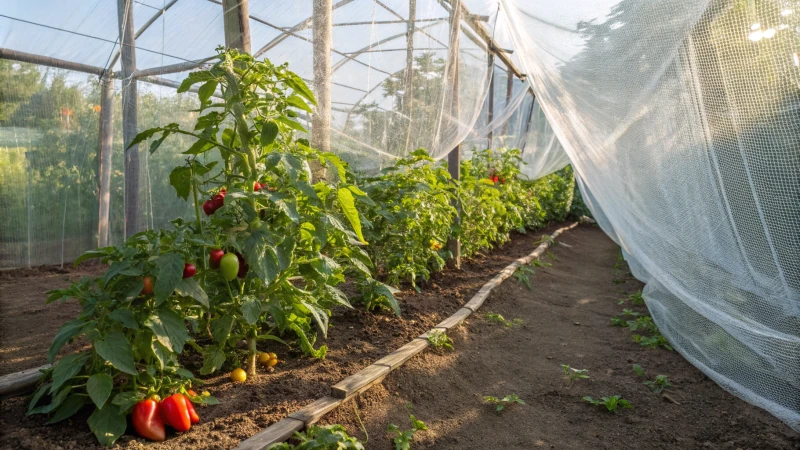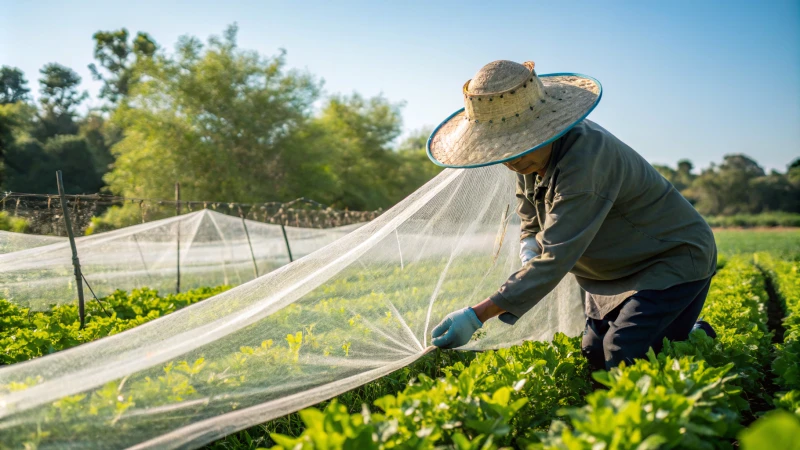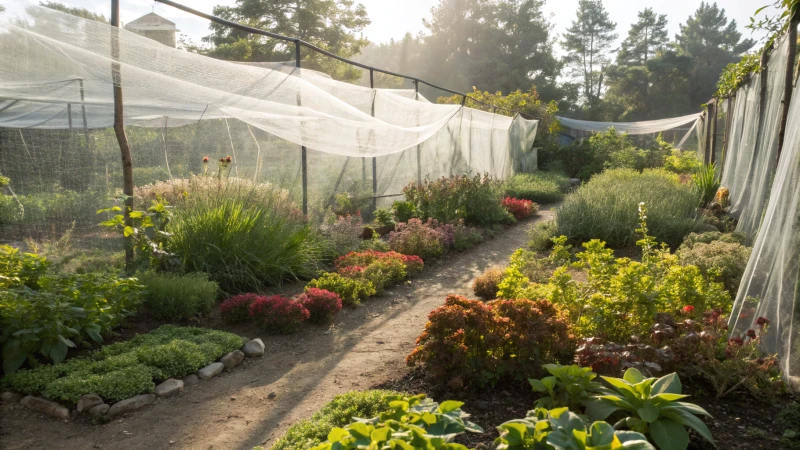
Have you ever asked yourself how a basic net changes your gardening or farming?
Choosing insect netting requires picking the correct mesh size for keeping pests away. Cover all plant areas that need protection. Regular care increases its lifespan and efficiency. Proper attention is really important.
I recall the first time I placed insect netting over my small garden. Excitement and uncertainty filled me. Netting isn't just about covering plants. You must know the right mesh sizes for each pest. It's like finding the right glove size. It really matters. Proper setup keeps your precious greens safe, with no gaps for sneaky bugs. Regular care maintains the net's strength year after year. It's just like looking after a favorite jacket. Let's dive into these basics to really improve your pest control strategies.
Insect netting is only effective against large pests.False
Insect netting is effective against various pest sizes, depending on mesh.
Proper installation of insect netting enhances crop protection.True
Ensuring full coverage of plants maximizes the netting's effectiveness.
How Do You Choose the Right Insect Netting Material?
Picture yourself in your garden, the sun gently warming your back while you look over the rows of healthy fruit trees. But pests hide in the shadows, prepared to ruin all your efforts. Different insect netting keeps these pests away. Let's discover the best one.
Choose insect netting by looking at mesh size, durability and UV protection. Mesh size must fit the pests you want to block. Select strong materials that handle weather well. UV protection is very important to keep the netting lasting longer. UV protection matters.

Understanding Mesh Size and Pest Type
In my early days of farming, I did not realize how vital mesh size was. Tiny aphids slipped through, causing great damage to my plants. For pests like aphids, smaller mesh below 0.8 mm is important. Bigger pests, like locusts, need mesh between 2-3 mm.
| Pest Type | Recommended Mesh Size |
|---|---|
| Aphids | 0.8 mm or smaller |
| Locusts | 2-3 mm |
Evaluating Material Durability
Choosing tough materials has always mattered to me. Polyethylene1 and polypropylene2 serve really well. Polyethylene offers lightness and strength, ideal for windy places. Polypropylene works well with chemicals. These materials have saved me much time and money.
Considering UV Resistance
Ignoring UV resistance was a mistake I once made. Seeing netting fall apart under strong sunlight is unpleasant. Selecting netting with UV stabilizers prevents destruction and helps it last longer. It is essential to extend the life of your nets.
Factoring in Cost-Effectiveness
Quality is often more valuable than cost to me. Durable netting may seem costly, but it reduces replacements and raises crop yield with time. Probably a good idea to compare suppliers for price and trustworthiness by checking their supplier backgrounds3.
Customization and Installation Options
Every farm is different in its needs. A standard net didn't fit my orchard once - it was very frustrating! Now, customized sizes and installation help are what I look for in suppliers. Installing nets becomes easier with bespoke options.
Balancing these factors - mesh size, material toughness, UV protection, cost balance, and custom options - has protected my fields well. Hopefully, these tips help you choose wisely for your farm needs.
Polyethylene is ideal for windy regions.True
Polyethylene is lightweight yet sturdy, making it suitable for wind.
Aphids require a mesh size of 2-3 mm.False
Aphids need a mesh size of 0.8 mm or smaller to prevent access.
How do you effectively install insect netting?
Have you ever tried to keep small pests away from your cherished plants? Blocking insects is only part of the task. Inviting helpful ones is also important.
Choose the correct netting material for insect netting. It should fit tightly. Check often for any damage. This protection keeps pests away from your crops. Air and sunlight still get through. This is very important.

Choosing the Right Material
I remember picking insect netting for the first time. It felt like wrapping a cloak around my dear plants. Choosing the right one is crucial. Consider mesh size, UV protection, and how strong it is.
| Mesh Size | Suitable For |
|---|---|
| Fine | Tiny bugs such as aphids |
| Medium | Allows in pollinators4 |
UV resistance protects against harsh sun rays for a long time. Nothing feels worse than seeing your netting fall apart when you need it the most. Really, nothing.
Installation Techniques
Think of installation like tucking your plants in for sleep. Keep it snug but allow space to grow. Sturdy frames, like those made from PVC or metal, support the netting well.
- Frame Construction: Strong frames mean less stress. Seriously, rely on this.
- Fastening: Use clips or zip ties to hold everything tight; think of them as suspenders for your net.
- Edge Sealing: Seal the edges to keep unwanted guests out with soil or weights—highly effective.
Regular Maintenance and Inspection
Checking on your netting regularly is like routine health visits for your plants—essential. Look for tears or holes and fix them quickly. Watch for sagging or dirt piling up; a quick hose can work wonders.
Common Issues and Solutions
By following these steps, you create a safe space for your crops to grow strong against pests.
| Issue | Solution |
|---|---|
| Tears/Holes | Repair with patches or sewing kits |
| Sagging | Tighten using additional clips or ties |
| Debris Accumulation | Regular cleaning with water hose |
Want to learn more? Explore expert installation tips5 to improve your setup further.
Fine mesh netting blocks pollinators.True
Fine mesh prevents tiny insects and also restricts pollinator access.
Regular maintenance is unnecessary for insect netting.False
Regular checks prevent pest intrusion by identifying tears or sagging early.
How Does Insect Netting Affect Plant Health and Growth?
I first used insect netting on my farm. I really noticed the difference. No more fights with bugs. No endless spraying sessions either!
Insect netting acts like a protective barrier for your plants. It keeps annoying insects away without using harsh chemicals. This netting also creates a safe and cozy space. Plants grow better in this environment. Plants grow really well.

The Mechanism of Insect Netting
Picture the ease of not worrying about bugs eating your crops. Insect netting acts like an invisible wall, stopping these tiny pests. I recall the first time I put it to use; my crops changed dramatically. They grew healthier, produced more, and I avoided pesticides that always left me uneasy.
| Type of Pest | Common Effects on Plants |
|---|---|
| Aphids | Sap extraction, disease spread |
| Beetles | Leaf damage, root destruction |
| Caterpillars | Defoliation, growth inhibition |
Microclimate Control with Insect Netting
Insect netting brings a surprising benefit. It creates a stable microclimate. Each plant feels like it has its own small greenhouse. This transformed my growing experience, particularly during unpredictable weather. The netting reduced wind harm and kept humidity right where it needed to be. My plants thrived, even when the weather didn't want to help.
For example, netting can help reduce wind speed and protect plants from damage. Microclimate adjustments6 can significantly impact plant health by preventing stress-related issues.
Balancing Light and Growth with Insect Netting
Plants love sunlight, but getting the right amount can be tricky. I initially worried that insect netting would block too much light. The right netting let plenty of sun through while blocking harmful UV rays. It was like giving my plants the perfect sunlight dose.
Types of insect netting7 are available with varying light transmission rates. Understanding these options can help farmers choose the best netting for their specific needs.
Potential Challenges and Considerations
Challenges arise with any method. Setting up the netting required practice - it had to be perfect to avoid reduced pollination. I had to tweak the mesh size and sometimes did manual pollination. Finding the right balance was key.
While initial costs and maintenance are factors, understanding these aspects maximizes benefits and controls downsides. Installation tips are vital to help the process flow and let you enjoy the fruits of your labor.
Installation tips8 can guide users in setting up their netting effectively, ensuring long-term benefits.
Insect netting reduces the need for chemical pesticides.True
Insect netting acts as a barrier, keeping pests away from plants.
Insect netting always improves pollination in crops.False
Netting can hinder pollination if the mesh is too fine.
How Can I Extend the Lifespan of My Insect Netting?
Do you feel your insect netting should last longer? Simple care tips help extend its life. Regular cleaning is very important. Gentle washing removes dirt. Dirt weakens the material. Try to keep it dry. Mold often grows on wet netting. Store it properly when not in use. A safe storage place protects it. Really avoid sharp objects nearby. Sharp edges easily tear the netting. These steps are simple but effective. Yes, they are very effective!
Wash your insect netting gently with mild soap and water sometimes. Avoid piercing or tearing it with sharp objects. Store it in a dry, shady place when not in use. Store it carefully. It is important.

Routine Cleaning Habits
Possessions look worse when neglected. Like my cap left outside, badly affected by weather. Regular cleaning really keeps insect netting in good condition. A mild soap with warm water wash removes dirt and helps airflow.
Gentle Handling
I once eagerly used tools, cutting the netting by mistake. It hurt! Now, insect netting is a delicate treasure for me. Keep sharp tools away. Moving it? Check for anything sharp nearby.
Storage Secrets
Storage surprises me - rolled, not folded netting lasts longer! Keeping it dry and shaded prevents mold. It stays strong.
Storage Guidelines Table:
| Tip | Description |
|---|---|
| Dry Thoroughly | Ensure netting is dry to prevent mold. |
| Roll, Don't Fold | Rolling avoids weakening creases. |
| Use a Shaded Area | Store in a cool, shaded location to avoid UV damage. |
Repair and Maintenance Inspections
Seeing a tear is dreadful. Do not worry! Regular inspection means fixing small problems early. Special repair kits simplify patching without trouble.
UV Protection Awareness
Sunlight helps and harms. A sunny day is lovely, but too much sun damages insect netting. UV-resistant options help. Store indoors or cover with a tarp if not used.
Care for your insect netting! You save money and protect crops. Treat it kindly; it probably serves well every season. Learn more on agriculture practices9.
Regular cleaning prevents netting clogging.True
Cleaning removes dirt, maintaining airflow and effectiveness.
Folding netting is better than rolling for storage.False
Rolling prevents creases that weaken the fibers.
Conclusion
Insect netting protects crops from pests while allowing air and sunlight. Choosing the right mesh size, material durability, and regular maintenance enhances its effectiveness for healthier plants.
-
Click to discover why polyethylene is preferred for its lightweight and durable properties in windy regions. ↩
-
Learn about polypropylene's resistance to chemicals, offering an edge over other materials. ↩
-
Find trusted suppliers who offer customization to meet specific farm needs and dimensions. ↩
-
Learn how pollinators contribute to crop yield, highlighting the importance of allowing their access through insect netting. ↩
-
Explore detailed guides and expert advice on setting up various types of agricultural netting. ↩
-
This link explores how insect netting modifies microclimates, offering insights into managing temperature and humidity for optimal plant health. ↩
-
Learn about various insect netting types and their specific applications to select the most suitable one for your farming needs. ↩
-
Discover effective installation methods to ensure your insect netting provides maximum protection and longevity. ↩
-
Explore advanced techniques for maximizing crop protection through various agricultural practices. ↩

